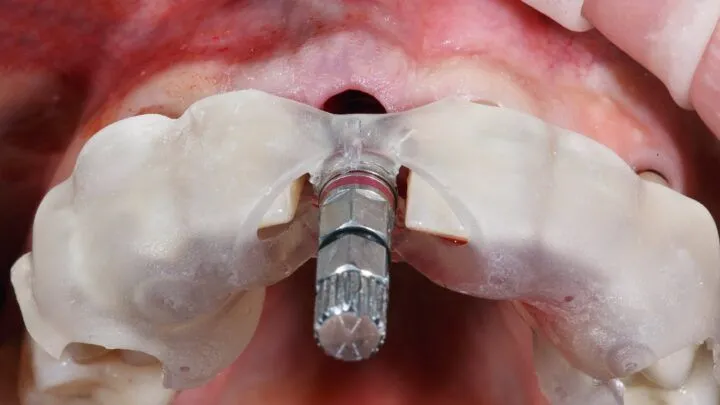Dental implants are devices designed to replace one or more natural teeth with artificial units. Many solutions are available, but in cases of excessive bone loss that cannot be regenerated, a zygomatic implant is preferred, subject to the opinion of a specialist.
So, let’s take a look at what we’re talking about, the main differences with traditional systems and when the prosthesis can be loaded. In the second and final section, however, we focus on the ideal patient profile and the possible side-effects of a procedure of this type.
What are zygomatic implants?
Zygomatic implants are special dental implants for use in cases of severe loss of bone structure that cannot be regenerated using other surgical techniques. In fact, jawbones of poor quality and quantity cannot be loaded with traditional braces, as they lack the base where the appliance is fixed and osseointegration takes place. Zygomatic implants, however, exploit the cheekbone, to which they are attached diagonally.
The surgical technique for zygomatic implants in Turkey involves a preliminary analysis which, by means of radiological examinations, photographs and possible casts, enables the subsequent phases to be programmed.
The actual operation involves the insertion of titanium implants (screws measuring from 2 to 5 centimetres) into the bone tissue, at the ends of which are healing screws that close the implant. After a period of approximately three months, necessary to allow the implant to osseointegrate, these healing screws are removed to allow the abutment to be applied, onto which the temporary prosthetic crown is cemented. After a variable period of time, depending on the state of the zygomatic bone, the definitive denture is fitted.
This method avoids the need for bone tissue grafting, a particularly complex procedure requiring very long lead times, both because the tissue has to be taken from another part of the body and because of the time needed for the graft to take root. In the case of surgery with zygomatic implants, the great advantage of having a usable set of teeth available within a few days of surgery is offered, without any waiting.
The success rate of this implantology technique is between 96% and 98% of cases, twelve years after the operation; these are very high values that confirm the validity and effectiveness of this method.
Main differences between traditional and zygomatic implants
The traditional implant is attached to the jawbone, while the zygomatic implant is attached to the cheekbone. The different anchorage points are also reflected in the overall length of the appliance: the traditional implant is only 18 mm long, while the zygomatic implant is 55 mm long, as it has to reach a higher bone.
Zygomatic implant and prosthesis loading
The surgical procedure for inserting zygomatic implants in Turkey is more complex, but that doesn’t mean you have to wait to load the prosthesis. These devices are generally immediately loadable, and the provisional prosthesis can be inserted at the end of surgery, enabling an immediate return to daily life. The definitive device, however, is fixed at the end of the osseointegration and healing process of the gingiva and tissues around the implant.
The best candidates for a zygomatic implant
Before undergoing dental implant surgery, you should contact your trusted dentist for a thorough examination. Here, the specialist assesses the condition of the oral cavity and accurately estimates the amount of bone and its relative density using X-rays and other state-of-the-art tests; age and lifestyle complete the clinical picture so as to define the most suitable treatment for you.
Generally speaking, elderly people who have been missing teeth for a long time are the best candidates for zygomatic implants.
Finally, the zygomatic implant has a high probability of success because the bone guarantees excellent osseointegration conditions and is not subject to deterioration due to age, oral cavity pathologies or lack of dental elements. The operation is performed under local anaesthetic and conscious sedation, and is therefore more invasive than that required for traditional implants.
Zygomatic implants: side effects of surgery
The operation lasts a few hours and has no particular side effects; at the end of the procedure, you may experience pain and swelling in the affected area, but both conditions regress spontaneously within a few days. Follow the antibiotic treatment prescribed by your specialist, and use ice and painkillers to reduce painful symptoms.
Implant side effects
Sinusitis. Headaches, constipation, excessive mucus production and facial pain are the most common side effects after surgery. They can also be alleviated by simple nasal washes or by fumigation with mint and eucalyptus essential oils.
Sinus-oral fistula. In general, the pathological tubular lesion should regress on its own, or non-invasive surgery may be required.
- Necrosis of the upper part of the implant
- Altered tooth sensitivity
- Failure of osseointegration.
- Advantages of zygomatic implants
- Zygomatic implants offer a long list of advantages, which can be summarized as follows.
- Reduced waiting times
- Guaranteed success in most cases
- Immediate loading possible
- Low costs compared with bone reconstruction.
How long does a zygomatic implant last?
On average, a zygomatic implant lasts between 10 and 15 years, but it’s impossible to make a priori predictions, since everything depends on a number of factors, including the patient’s age.
For older people, the device is designed to last a lifetime, while for younger people, it’s essential to take into account natural wear and tear over time.
Turquie Santé offers you the best prices for zygomatic implants in Turkey.
If you want to keep your zygomatic implant for as long as possible, don’t forget to lead a healthy lifestyle and perform good oral hygiene procedures. Respecting these simple rules is essential if you don’t want to risk having to replace the appliance prematurely.







